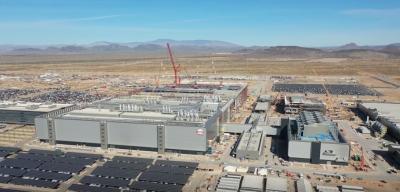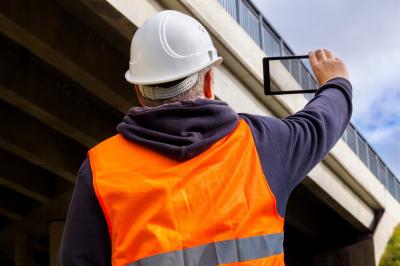The crack of the bat is not the only sound Cardinals baseball fans are hearing at Busch Stadium this summer.
The sound of driving piles might be heard above the roar of the crowd during day and night games as work continues on the new $387-million facility during the 2005 baseball season.
“We’re a year-and-a-half away from completion, but only a year until the next baseball season,” said Craig Lamping, project manager. “We’ll be 5,000 seats short of capacity on opening day [2006], with work on the left field upper decks scheduled last.” He added that construction may even continue into the 2006 season.
However, full capacity in the new stadium will not match that of the old ball park. While the old stadium held 48,000 fans –– 56,000 at its peak –– the new stadium will accommodate only 43,000.
“The new trend in design calls for less seating capacity,” explained Lamping. “A smaller stadium gives a more intimate feeling.”
Instead, fans will benefit from an increased number of concession stands and restrooms –– the highest per-person percentage of restrooms in any baseball stadium.
“Quality is the driving force,” Lamping said. “There are a lot of ways to spend money. We want [Cardinals games] to be a good experience [for fans].”
The general consensus is that the old ballpark was not providing a good experience for fans. Built in 1966, the same year as the Gateway Arch, Lamping said the stadium is old and in need of maintenance.
Team Manager Tony La Russa told the Associated Press that “Underneath, more and more every year, there’s problems — leaks, smells and all kinds of nasty stuff. So it is time for a ballpark to be built.”
La Russa is not the only one who believes it is time for a new stadium. The staunch St. Louis fan base supports the project and the team.
“The strong fan base is one of the reasons the new stadium is being built,” Lamping said, adding that a determining factor in the decision to build was the desire to get these devoted fans closer to the action. “The old stadium was designed for baseball and football, which means some seats are far from the diamond. St. Louis loves the Cardinals and the fans want to be closer to the action.”
He reported ticket sales for the 2005 season have already surpassed $3 million and 12 games were sold out before Opening Day. In addition, fans are clamoring for memorabilia from the old stadium, even before demolition has begun. Because pre-orders for seats to be removed from the old stadium have flooded the office, the ball club has brought an auction company on board to handle the distribution of pieces of the old ballpark that have not been deemed museum quality.
“We’re re-using some materials from the old stadium, but quite honestly, they’re worth more to sell. Everything has value,” said Lamping as he relates that a visiting pitcher’s warm-up mound from the World Series went for a bid of $24,000. “Besides, the technology has changed since 1966, and we want the best materials in the new stadium.”
In addition to sales of memorabilia, bond issues have raised money for the project, but Lamping hinted that the Cardinals would be paying the bulk of construction costs –– at least until Anheuser-Busch inked a new naming-rights deal, picking up a significant but undisclosed share of the cost.
Three iterations of Cardinals baseball stadiums have carried the Busch banner. Anheuser-Busch Vice President of Global Media and Sports Marketing Tony Ponturo told the media during the official announcement,
“We looked at the tradition and the legacy. When you have something for 50 years that’s called Busch Stadium, we felt that it wouldn’t be appropriate to do anything other than that. We could not be more proud of this relationship or more excited about the prospects for the future.”
The team’s principal owner, William O. DeWitt Jr., echoed Ponturo’s sentiments and said, “It just wouldn’ be Cardinals baseball without Busch Stadium.”
First Inning
Even before groundbreaking ceremonies were held in January 2004, preparatory work had begun in downtown St. Louis. Lamping said approximately eight months of groundwork preceded work on the actual stadium grounds. The Missouri Department of Transportation, with financial incentives paid by the baseball club owners, demolished a highway ramp and a pedestrian bridge, and relocated a new ramp south of Highway 40.
In addition, “There was a lot of utility relocation and street/highway work,” he said. “We found a lot of things underground we didn’t expect, even though we did research to try to know what to expect. That delayed us a little. We had to abide by environmental regulations when we found things like lead paint.”
Despite some unanticipated slow-downs, Lamping said that work is two to three weeks ahead of schedule, and will remain so as long as the weather cooperates. Once work on the stadium commenced, it got going at a rapid pace.
“There are penalties for being late,” said Lamping, who went on to note that Hunt Construction, based in Indianapolis, has built 10 of 12 recent stadiums in the United States. “They have a lot of experience at this,” he added.
To date, Lamping said little overtime or premium work hours have been required, but he predicts that the 500 crewmen currently working only the day shift will soon be getting ready to go to shift work. John Lloyd, the owner’s representative of the project, understands that the condensed 28-month construction schedule could dictate around-the-clock work to meet its deadline and has planned ahead in anticipation of running three shifts.
Seventh-Inning Stretch
Lamping does not envisage any complications due to shift work. Security staff and fencing will keep fans out of harm’s way, although Lamping said they will be able to see and hear some of the work during games.
However, he said, “For some reason a lot of people watch the construction as much as they watch the game.”
Two-thirds of the new stadium are in place, according to Lamping, who said steel and precast now reach their full height. The service level, suites and mechanical systems are expected to be complete by October 2005.
“We’ll be done with the bulk of the occupied area by then,” Lamping said.
The trick is that the new stadium is designed around the old one, with approximately half of it overlapping the actual ground the other sits on.
“Originally, we were going to have to tear down part of the stadium to finish construction, but they tweaked the design so the Cardinals can play in a complete stadium. We’re pushing the envelope, but I think it will work out,” Lamping said.
The plan called for numerous upgraded features and amenities, such as wider concourses throughout the stadium, elevators and escalators between levels and perfect baseball sight lines for all seats.
“We’re currently blocking out restrooms and concession stands,” Lamping said.
In addition to the increased number of restrooms and concession stands, standing room and gathering areas will provide fans with opportunities to enjoy the ballpark and view the action on the field.
Viewing was an important consideration in the design of the new stadium. The orientation of the field is changing. Home plate will reside in the southwest corner of the site, which not only provides a better angle of the sun, but also frames dramatic views of the Gateway Arch and downtown skyline.
This is helped by the lowered seating and scoreboards in center field, as well as the natural slope. Once the old stadium is demolished and Clark Street is rebuilt, motorists traveling the downtown thoroughfare can take advantage of unobstructed views of the playing field. Balconies and rooftops of the new buildings in the planned Ballpark Village will offer platforms for viewing the outfield.
The connection with the city is no accident. Throughout the project, Hunt Construction and the Cardinals have worked with the city, local businesses and residents to minimize inconvenience.
“It’s not an adversarial relationship,” said Lamping. “We met with businesses early on about noise levels, access issues … We’ll let neighbors know about the demolition schedule. We anticipate imploding the old stadium about three weeks after the last game of the [2005] season, and we’ll keep everyone apprised of that date.”
The Cardinals have added a construction link to its Web site to keep fans informed of progress and restrictions. Lamping said access to the stadium remains unchanged for now, and that only one small VIP parking lot has been eliminated.
Home Run
City officials expect the revitalized baseball stadium to spark a downtown renaissance, noting the concurrent renovation of some loft apartments in the vicinity. Ballpark Village itself will contribute to the rejuvenation of the area by housing retail, entertainment, office, restaurant and residential facilities.
Cardinals President Mark Lamping said, “Our hope is that Ballpark Village will become a vibrant neighborhood with activity 365 days of the year.”
The Cardinals plan to locate a team museum in Ballpark Village directly across from the new stadium, anticipated to open within a couple years of the new stadium.
Designers of the new Busch stadium incorporated the city’s past in their forward-thinking plan, blending St. Louis’ history with the fans’ love of baseball. The creative use of old and new materials, including brick, concrete, exposed steel and glass, signifies continuity and tradition. Classic arched openings recall the nearby Cupples Station warehouses, while warm colors mimic the rich tones of the Wainright building.
Additional nods to history will be marked by landmarks in and around the ballpark to denote the locations of significant moments and to mark the site of the old stadium.
The labor of love and pride continues from design to construction. Lamping indicates that 80 percent of the work is being performed by St. Louis-based contractors and subs.
“Some of the guys are sons of men who worked on the last stadium,” he said. “The workers take a lot of pride in this project — more than most. They know they’re making history.” CEG
Today's top stories















